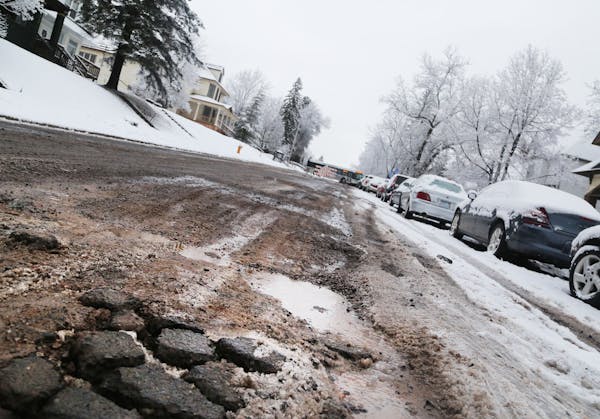Pothole season is in full swing in the Twin Cities, foretelling a busy summer of construction to come. But with additional freeze-thaw cycles on the horizon and asphalt plants still closed for the winter, all city workers can do for now is repeatedly fill Minneapolis' pockmarked streets with short-term cold patches lasting a few weeks each.
"I have directed director Margaret Anderson Kelliher and her Public Works team … with additional overtime hours and weekend hours to make sure we are filling as many of the potholes as we can while we wait for a permanent fix," said Mayor Jacob Frey, asking residents to be patient.
THE 'SCIENCE' OF POTHOLES

How potholes form
Potholes form when water enters cracks in the streets, freezes and expands, eventually blowing the asphalt open like a carbonated drink placed in the freezer, said Transportation Maintenance and Repair Director Joe Paumen.
Cold patches are good for sticking to wet potholes and are useful in less-than-ideal conditions. But they are more porous than hot asphalt, allowing water to trickle through and inevitably reopen the pothole.
Hot mix comes from metro plants that typically open around the first of April, Paumen said.
Once the freeze-thaw cycle finishes, the city can get down to business filling 200 potholes a day with hot patches that can last up to two years. Streets will be reconstructed according Minneapolis' 20-year street funding plan.
This winter is among the top 10 snowiest in recorded history. Combined with temperature swings and rain, potholes started appearing in January — a month or two earlier than normal.
Last year, the city used about 120 tons of patching material. It's gone through 274 tons so far this winter.
The city typically spends $1.5 million on reactive street repairs like potholes, Anderson Kelliher said. The last serious pothole season was the spring of 2013, which called for an extra $1 million. The city anticipates spending at least the same amount this year on materials and overtime hours.
She asked residents to call 311 to report especially odious potholes, and help clear out frozen drains on residential streets.
Neighbors, city officials at odds over Rochester lake dam

Souhan: This is KAT's chance to prove Flip Saunders was right

The story of Hercules the cat: Rescued in 2022, Target model in 2024

Minnesota State Patrol celebrates diverse new class of troopers

